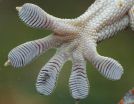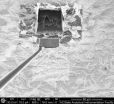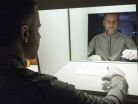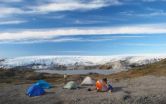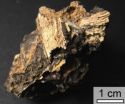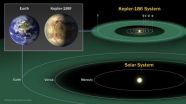(Press-News.org) AMHERST, Mass. – The ability to stick objects to a wide range of surfaces such as drywall, wood, metal and glass with a single adhesive has been the elusive goal of many research teams across the world, but now a team of University of Massachusetts Amherst inventors describe a new, more versatile version of their invention, Geckskin, that can adhere strongly to a wider range of surfaces, yet releases easily, like a gecko's feet.
"Imagine sticking your tablet on a wall to watch your favorite movie and then moving it to a new location when you want, without the need for pesky holes in your painted wall," says polymer science and engineering professor Al Crosby. Geckskin is a 'gecko-like,' reusable adhesive device that they had previously demonstrated can hold heavy loads on smooth surfaces such as glass.
Crosby and polymer science researcher Dan King, with other UMass Amherst researchers including biology professor Duncan Irschick, report in the current issue of Advanced Materials how they have expanded their design theory to allow Geckskin to adhere powerfully to a wider variety of surfaces found in most homes such as drywall, and wood.
Unlike other gecko-like materials, the UMass Amherst invention does not rely on mimicking the tiny, nanoscopic hairs found on gecko feet, but rather builds on 'draping adhesion,' which derives from the gecko's integrated anatomical skin-tendon-bone system. As King explains, "The key to making a strong adhesive connection is to conform to a surface while still maximizing stiffness."
In Geckskin, the researchers created this ability by combining soft elastomers and ultra-stiff fabrics such as glass or carbon fiber fabrics. By "tuning" the relative stiffness of these materials, they can optimize Geckskin for a range of applications, the inventors say.
To substantiate their claims of Geckskin's properties, the UMass Amherst team compared three versions to the abilities of a living Tokay gecko on several surfaces, as described in their journal article this month. As predicted by their theory, one Geckskin version matches and even exceeds the gecko's performance on all tested surfaces.
Irschick points out, "The gecko's ability to stick to a variety of surfaces is critical for its survival, but it's equally important to be able to release and re-stick whenever it wants. Geckskin displays the same ability on different commonly used surfaces, opening up great possibilities for new technologies in the home, office or outdoors."
Crosby notes, "It's been a lot of fun thinking about all of the different things you ever would want to hang somewhere, and then doing it. Geckskin changes the way you think."
INFORMATION: END
Gecko-like adhesives now useful for real world surfaces
UMass Amherst inventors describe a new, more versatile version of their invention, Geckskin, that can adhere strongly to a wider range of surfaces, yet releases easily, like a gecko's feet
2014-04-18
ELSE PRESS RELEASES FROM THIS DATE:
'Exotic' material is like a switch when super thin
2014-04-18
ITHACA, N.Y. – Researchers from Cornell University and Brookhaven National Laboratory have shown how to switch a particular transition metal oxide, a lanthanum nickelate (LaNiO3), from a metal to an insulator by making the material less than a nanometer thick.
Ever-shrinking electronic devices could get down to atomic dimensions with the help of transition metal oxides, a class of materials that seems to have it all: superconductivity, magnetoresistance and other exotic properties. These possibilities have scientists excited to understand everything about these materials, ...
New study suggests a better way to deal with bad memories
2014-04-18
What's one of your worst memories? How did it make you feel? According to psychologists, remembering the emotions felt during a negative personal experience, such as how sad you were or how embarrassed you felt, can lead to emotional distress, especially when you can't stop thinking about it.
When these negative memories creep up, thinking about the context of the memories, rather than how you felt, is a relatively easy and effective way to alleviate the negative effects of these memories, a new study suggests.
Researchers at the Beckman Institute at the University ...
Impurity size affects performance of emerging superconductive material
2014-04-18
Research from North Carolina State University finds that impurities can hurt performance – or possibly provide benefits – in a key superconductive material that is expected to find use in a host of applications, including future particle colliders. The size of the impurities determines whether they help or hinder the material's performance.
At issue is a superconductive material called bismuth strontium calcium copper oxide (Bi2212). A superconductor is a material that can carry electricity without any loss – none of the energy is dissipated as heat, for example. Superconductive ...
Innovative strategy to facilitate organ repair
2014-04-18
This news release is available in French. A significant breakthrough could revolutionize surgical practice and regenerative medicine. A team led by Ludwik Leibler from the Laboratoire Matière Molle et Chimie (CNRS/ESPCI Paris Tech) and Didier Letourneur from the Laboratoire Recherche Vasculaire Translationnelle (INSERM/Universités Paris Diderot and Paris 13), has just demonstrated that the principle of adhesion by aqueous solutions of nanoparticles can be used in vivo to repair soft-tissue organs and tissues. This easy-to-use gluing method has been tested on rats. When ...
Under some LED bulbs whites aren't 'whiter than white'
2014-04-18
For years, companies have been adding whiteners to laundry detergent, paints, plastics, paper and fabrics to make whites look "whiter than white," but now, with a switch away from incandescent and fluorescent lighting, different degrees of whites may all look the same, according to experts in lighting.
"Retailers have long been concerned with the color-rendering qualities of their lighting, but less aware how light sources render white," said Kevin W. Houser, professor of architectural engineering, Penn State.
Not long ago, the only practical choices for home, office ...
Frozen in time: 3-million-year-old landscape still exists beneath the Greenland ice sheet
2014-04-18
Some of the landscape underlying the massive Greenland ice sheet may have been undisturbed for almost 3 million years, ever since the island became completely ice-covered, according to researchers funded by the National Science Foundation (NSF).
Basing their discovery on an analysis of the chemical composition of silts recovered from the bottom of an ice core more than 3,000 meters long, the researchers argue that the find suggests "pre-glacial landscapes can remain preserved for long periods under continental ice sheets."
In the time since the ice sheet formed "the ...
Impact glass stores biodata for millions of years
2014-04-18
PROVIDENCE, R.I. [Brown University] — Asteroid and comet impacts can cause widespread ecological havoc, killing off plants and animals on regional or even global scales. But new research from Brown University shows that impacts can also preserve the signatures of ancient life at the time of an impact.
A research team led by Brown geologist Pete Schultz has found fragments of leaves and preserved organic compounds lodged inside glass created by a several ancient impacts in Argentina. The material could provide a snapshot of environmental conditions at the time of those ...
'Dressed' laser aimed at clouds may be key to inducing rain, lightning
2014-04-18
The adage "Everyone complains about the weather but nobody does anything about it," may one day be obsolete if researchers at the University of Central Florida's College of Optics & Photonics and the University of Arizona further develop a new technique to aim a high-energy laser beam into clouds to make it rain or trigger lightning.
The solution? Surround the beam with a second beam to act as an energy reservoir, sustaining the central beam to greater distances than previously possible. The secondary "dress" beam refuels and helps prevent the dissipation of the high-intensity ...
First Earth-size planet is discovered in another star's habitable zone
2014-04-18
A team of astronomers that includes Penn State scientists has discovered the first Earth-size planet orbiting a star in the "habitable zone" -- the distance from a star where liquid water might pool on the surface of an orbiting planet. The discovery was made with NASA's Kepler Space Telescope. The discovery of this Earth-size planet, now named Kepler-186f, confirms -- for the first time -- that planets the size of Earth exist in the habitable zone of stars other than our Sun.
Some planets previously had been found in the habitable zone, but they all were at least 40 ...
Scientists discover brain's anti-distraction system
2014-04-18
Two Simon Fraser University psychologists have made a brain-related discovery that could revolutionize doctors' perception and treatment of attention-deficit disorders.
This discovery opens up the possibility that environmental and/or genetic factors may hinder or suppress a specific brain activity that the researchers have identified as helping us prevent distraction.
The Journal of Neuroscience has just published a paper about the discovery by John McDonald, an associate professor of psychology and his doctoral student John Gaspar, who made the discovery during his ...
LAST 30 PRESS RELEASES:
Air pollution exposure and birth weight
Obstructive sleep apnea risk and mental health conditions among older adults
How talking slows eye movements behind the wheel
The Ceramic Society of Japan’s Oxoate Ceramics Research Association launches new international book project
Heart-brain connection: international study reveals the role of the vagus nerve in keeping the heart young
Researchers identify Rb1 as a predictive biomarker for a new therapeutic strategy in some breast cancers
Survey reveals ethical gaps slowing AI adoption in pediatric surgery
Stimulant ADHD medications work differently than thought
AI overestimates how smart people are, according to HSE economists
HSE researchers create genome-wide map of quadruplexes
Scientists boost cell "powerhouses" to burn more calories
Automatic label checking: The missing step in making reliable medical AI
Low daily alcohol intake linked to 50% heightened mouth cancer risk in India
American Meteorological Society announces Rick Spinrad as 2026 President-Elect
Biomass-based carbon capture spotlighted in newly released global climate webinar recording
Illuminating invisible nano pollutants: advanced bioimaging tracks the full journey of emerging nanoscale contaminants in living systems
How does age affect recovery from spinal cord injury?
Novel AI tool offers prognosis for patients with head and neck cancer
Fathers’ microplastic exposure tied to their children’s metabolic problems
Research validates laboratory model for studying high-grade serous ovarian cancer
SIR 2026 delivers transformative breakthroughs in minimally invasive medicine to improve patient care
Stem Cell Reports most downloaded papers of 2025 highlight the breadth and impact of stem cell research
Oxford-led study estimates NHS spends around 3% of its primary and secondary care budget on the health impacts of heat and cold in England
A researcher’s long quest leads to a smart composite breakthrough
Urban wild bees act as “microbial sensors” of city health.
New study finds where you live affects recovery after a hip fracture
Forecasting the impact of fully automated vehicle adoption on US road traffic injuries
Alcohol-related hospitalizations from 2016 to 2022
Semaglutide and hospitalizations in patients with obesity and established cardiovascular disease
Researchers ‘listen in’ to embryo-mother interactions during implantation using a culture system replicating the womb lining
[Press-News.org] Gecko-like adhesives now useful for real world surfacesUMass Amherst inventors describe a new, more versatile version of their invention, Geckskin, that can adhere strongly to a wider range of surfaces, yet releases easily, like a gecko's feet
